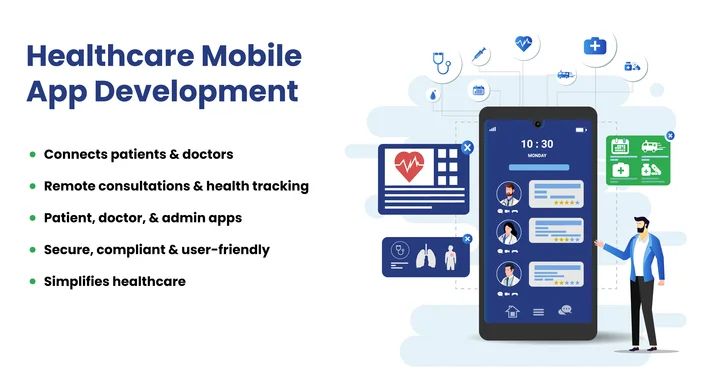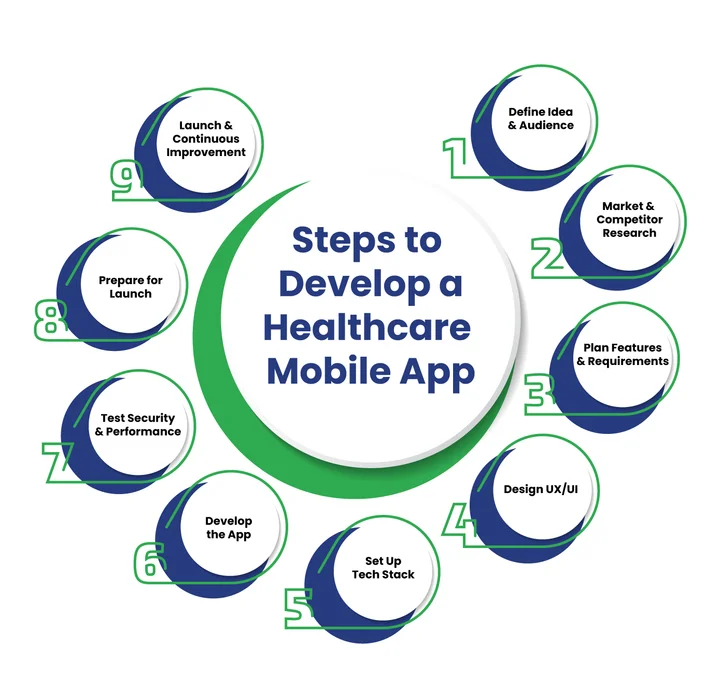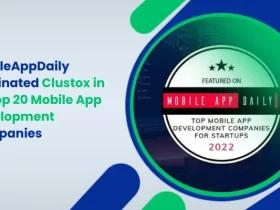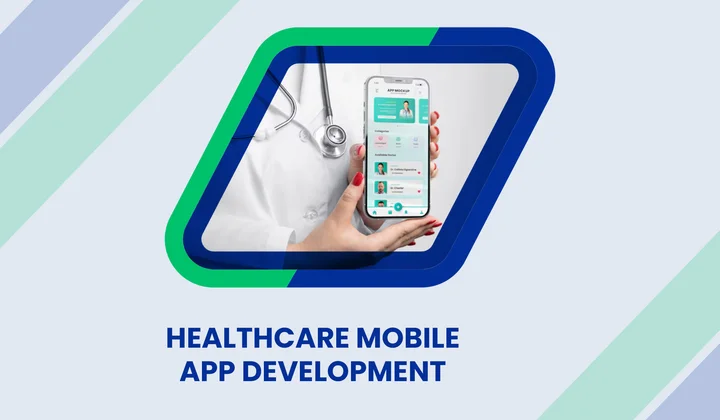Ever wondered how a simple app can make healthcare easier?
Mobile apps now help people book appointments, track health, and even consult doctors without leaving home. This shows how technology is reshaping everyday healthcare.
In fact, over 60% of U.S. adults use health apps regularly (thinkitive.com). This growing adoption shows just how much users value solutions that are simple, secure, and reliable. As healthcare continues to go digital, understanding these trends is key to building apps people truly trust and enjoy using.
But here’s the thing:
Developing a healthcare app takes much more than just writing code. It’s a blend of strategic planning, thoughtful design, and real-world usability. Each stage plays a vital role in ensuring your app meets patient needs and complies with healthcare standards.
So, if you’re ready to turn your idea into a functional, user-friendly healthcare app, let’s walk through the blog to know the entire process, step by step.
What Is Healthcare Mobile App Development, and Why Does It Matter?
Healthcare mobile app development is all about building digital solutions that connect patients, doctors, and healthcare providers through smartphones and tablets. These apps make it easier to access care, manage health data, and improve overall patient experiences.

Table of Contents
Think of it as combining technology, medical expertise, and user trust in one app.
Here’s what it includes:
- Patient-facing apps: For appointment booking, telemedicine, fitness tracking, or medication reminders.
- Doctor and hospital apps: For managing patient records, monitoring vitals, or coordinating care.
- Admin and analytics tools: For hospital management, billing, and performance tracking.
Why It Matters?
- Healthcare apps are a necessity.
- They make healthcare more accessible (remote consultations and online prescriptions).
- They reduce paperwork and manual errors through digital data management.
- They empower patients to take charge of their health anytime, anywhere.
- They help healthcare providers deliver better, faster, and more accurate care.
A Quick Reality Check
Building a healthcare app isn’t the same as creating any other mobile app. It requires:
- Compliance with data privacy laws like HIPAA, GDPR, and other regional regulations.
- Strong encryption and security to protect sensitive medical information.
- A user-friendly design that meets accessibility and medical standards.
In short, healthcare mobile app development bridges the gap between patients and providers, turning complex healthcare systems into simple, digital experiences that save time, build trust, and improve outcomes.
Not sure where to start with healthcare app development? Get clarity on strategy, compliance, and features that matter.
Now that you know what healthcare mobile app development involves, let’s start with the first step!

Step 1: Defining the App Idea and Target Audience
Every successful healthcare app starts with a clear purpose, solving a real problem for patients, doctors, or healthcare providers. Before you think about design or development, take time to define what your app will do, who it’s for, and why it matters.
Start with the Core Problem. Ask yourself:
- What specific issue will my app solve?
- Who benefits most: patients, doctors, or clinics?
- How will it improve existing healthcare workflows or experiences?
Clarity at this stage ensures your app addresses a real need, not just a nice-to-have feature.
1. Identify and Segment Your Target Audience
Your users determine your app’s direction.
- Patients need easy appointment booking, reminders, or symptom tracking.
- Doctors/clinics want efficient teleconsultation and record management tools.
- Startups often focus on innovative health tech app builds like telemedicine or wellness platforms.
Understanding your users early shapes both functionality and UX decisions later on.
2. Validate Your App Idea
Research the market, analyze competitors, and gather user feedback before starting the health app build. It ensures your concept is practical, relevant, and compliant with healthcare standards.
Once your app idea and audience are set, the next step is to explore the market and evaluate your competition.
Step 2: Conducting Market and Competitor Research
Once your app idea is defined, explore how it fits into the healthcare landscape. Market and competitor research helps you identify real needs, gaps, and opportunities before development begins.
1. Understand the Market
Study current healthcare trends and user expectations. Look for what’s missing: better usability, improved data privacy, or affordable digital health solutions. These insights ensure your app solves a real problem, not just adds another option.
2. Analyze Competitors
Review existing healthcare apps similar to yours. Note their strengths, weaknesses, and user feedback. Ask yourself:
- What do users like about these apps?
- Where do they struggle or lose trust?
Understanding this helps you learn from others’ successes and avoid common pitfalls.
3. Find Your USPs
Use your research to define what sets your app apart, maybe stronger security, simpler design, or a niche focus like mental health tracking. A clear Unique Selling Point (USP) shapes both your development strategy and your future marketing efforts.
With these insights in place, you’re ready to plan your app’s key features and technical requirements in Step 3.
Step 3: Planning Features and Functional Requirements
With your research complete, it’s time to turn your idea into a structured plan. This step defines what your healthcare app will do and how it will do it.
1. Outline the Core Features
List the essential functionalities your users need most. Depending on your app’s purpose, these could include:
- User registration and profiles
- Appointment booking and reminders
- Telemedicine or chat features
- Health tracking and analytics
- Secure data storage
Prioritize features that offer the greatest value first; as your app develops, you can add more features later.
2. Define Functional Requirements
Describe the backend logic and user flow for each feature. This documentation gives your development team a clear roadmap and helps estimate time and cost accurately.
3. Prioritize Security and Compliance
Since healthcare apps handle sensitive data, align your design and functionality with standards like:
- HIPAA (U.S.)
- GDPR (EU)
- HITECH Act
- FDA guidelines (for diagnostic or medical-use apps)
Integrating compliance early builds user trust and avoids costly fixes later.
Once your features and requirements are clearly defined, you’re ready to design the user experience, bringing your healthcare app to life visually in Step 4.
Step 4: Designing the User Experience (UX/UI)
Once your app’s features are set, the next step is to shape how users will interact with it. A thoughtful design makes your healthcare app not only functional but also trustworthy and easy to use.
1. Keep It Simple and Accessible
Healthcare apps serve people of all ages and backgrounds, so clarity is key. Use clean layouts, readable text, and intuitive navigation. Follow accessibility standards (like WCAG) to support users with different abilities.
2. Design with Empathy and Trust
The look and feel of your app should inspire confidence. Choose calm colors, familiar icons, and transparent data-sharing prompts. If you’re partnering with a team that offers UI/UX design services, make sure they understand that healthcare-specific design principles, empathy, compliance, and clarity matter just as much as visuals.
3. Test Early and Refine
Before development begins, build wireframes or interactive prototypes. Share them with real users to see what works and what confuses them. Early feedback helps you fix usability issues before they become costly.
In essence, good UX/UI design bridges technology and care. Once your user experience feels intuitive and reliable, it’s time to select the right tech stack and prepare for development in Step 5.
Step 5: Setting Up the Tech Stack for Health Tech App Build
Once your app design is ready, it’s time to choose the right technologies to build and scale it. The tech stack you select will determine how well your healthcare app performs, integrates, and stays secure over time.
If you’re partnering with a team that offers software development services, make sure they have experience with healthcare solutions and data-sensitive architectures.
1. Pick the Right Technologies
Pick tools that align with your app’s goals and complexity:
- Frontend: React Native, Flutter, or Swift for smooth, responsive interfaces.
- Backend: Node.js, Python (Django), or .NET for reliable server-side logic.
- Database: PostgreSQL or MongoDB for efficient, secure data management.
A strong technical foundation ensures scalability and consistent performance.
2. Build with Security in Mind
Healthcare apps handle sensitive data, so prioritize security features such as encryption, access control, and secure APIs. These measures protect user information and maintain trust throughout your app’s lifecycle.
3. Plan for Integration and Growth
As your app evolves, you may need to integrate with EHR systems, wearable devices, or analytics tools. Choosing flexible frameworks and scalable infrastructure now will save time and cost later.
With your tech stack in place, the next step is to bring your plan to life and begin the actual healthcare mobile app development process.
Step 6: Developing the Healthcare Mobile App
With your features planned, design finalized, and tech stack ready, it’s time to start building. This phase turns your vision into a working product through structured development cycles and quality testing.
1. Set Up the Development Environment
The development team sets up servers, databases, and frameworks, preparing them for coding. Clear documentation of the mobile health application development process helps maintain consistency across both frontend and backend development.
2. Agile Development and Feature Integration
Most healthcare mobile app projects follow Agile or Scrum methodology. This allows teams to build and test features in short sprints and incorporate feedback quickly. Core functionalities often include:
- Secure login and authentication
- Appointment scheduling and telemedicine modules
- Real-time data syncing with wearable devices
- Push notifications and in-app messaging
3. Prioritizing Data Security
Throughout development, ensure security measures like encryption, access control, and secure APIs are integrated. This builds trust and keeps sensitive patient data protected.
Following these steps ensures your health tech app build meets quality, security, and compliance standards before going live.
Step 7: Testing for Security, Performance, and Compliance
After development, thorough testing ensures your healthcare software development project is secure, reliable, and ready for users. This step is crucial for building confidence and meeting regulatory standards.
1. Test for Functionality and Performance
Check every feature to confirm it works as intended across different devices and operating systems. Load testing helps measure how your app performs under heavy usage, ensuring it remains stable even during peak activity.
2. Conduct Security and Compliance Audits
Since healthcare apps handle sensitive information, security testing is essential. Review encryption methods, data transmission, and user access controls. Make sure your app meets regulatory requirements (HIPAA, GDPR, and HITECH); these ensure data is stored and shared safely.
3. Validate User Experience (UAT)
User Acceptance Testing (UAT) allows real users or healthcare professionals to try the app and provide feedback. Their insights help identify any usability gaps before public release.
4. Launch Optimization
Fix any identified issues and perform a final review of functionality, speed, and security. A well-tested app ensures a smooth experience and builds user confidence from day one.
With launch preparation complete, your app is ready to go live.
Step 8: Preparing for Health App Launch
After preparing your app for release, the next step is to make it available to users and ensure it performs well post-launch. This stage is critical in healthcare mobile app development to maintain trust and user satisfaction.
1. Submit to App Stores
Prepare your app assets, such as icons, descriptions, screenshots, and demo videos. Follow the submission guidelines for both iOS and Android platforms, and use relevant keywords to improve visibility in app stores.
2. Monitor App Performance
Once live, track essential metrics such as downloads, acive users, and retention. Analytics tools help you understand user behavior and identify areas that may need improvement or quick fixes.
3. Gather and Act on Feedback
It encourages users to share reviews or report issues directly through the app. Addressing their concerns promptly helps strengthen trust and improve future updates.
4. Maintain Security and Compliance
Regularly audit your app to ensure it continues to meet healthcare standards and privacy laws. Ongoing compliance keeps your app credible and secure as it grows.
After your app has been launched successfully and is being monitored, Step 9 involves maintaining momentum to ensure long-term success and ongoing improvement.
Step 9: Continuous Improvement and Updates
Launching your app is just the beginning. The real success of a healthcare app depends on how well it evolves to meet changing user needs, technology updates, and compliance standards. Regular updates not only fix bugs but also improve performance, design, and security.
1. Monitor User Feedback and Analytics
Keep an eye on user reviews, ratings, and usage metrics. Insights from analytics tools help identify which features users love and which ones need improvement.
2. Plan Regular Feature Upgrades
As healthcare trends and patient expectations shift, new opportunities will emerge. Through custom healthcare app development, you can continuously add features like AI-based symptom tracking, teleconsultation upgrades, or wearable integrations to stay ahead.
3. Maintain Security and Compliance
Healthcare regulations evolve over time, so periodic audits are essential. Update encryption methods, privacy policies, and data handling practices to ensure ongoing compliance.
4. Scale as Your User Base Grows
If your app gains more users or new partners, ensure your backend and infrastructure can handle the increased load. Scalable architecture helps your app grow smoothly without downtime.
Continuous improvement keeps your healthcare app relevant, user-friendly, and secure, ensuring it delivers lasting value for both patients and providers.
Frequently Asked Questions (FAQs)
2. What are the Biggest Challenges in Healthcare App Development?
Particular challenges include:
- Ensuring data security and encryption for sensitive patient information
- Meeting regulatory compliance (HIPAA, GDPR, HITECH)
- Integrating with EHR systems and other health platforms
Designing a user-friendly experience for diverse users, from patients to doctors
Balancing technical requirements with patient-centric design is crucial for long-term success.
3. How Can Healthcare Apps Improve Patient Engagement?
Healthcare apps increase patient engagement by providing personalized notifications, medication reminders, teleconsultations, and health tracking dashboards. Gamification features, such as daily step goals or wellness challenges, can further motivate users and encourage consistent app use.
4. Should Startups Prioritize Compliance or Features First?
Compliance should always be integrated from the start. Regulatory requirements like HIPAA or GDPR are not optional, and designing your features around these standards saves costly redesigns later. Once compliance is ensured, focus on building intuitive features that improve patient and provider experience.
Final Takeaway: Turning Your Healthcare App Idea into a Trusted Digital Solution
Turning a healthcare app idea into reality can feel complex at first.
You start with questions: what features should it have, or how can it stay secure and user-friendly?
As you move from planning to design, development, and testing, each step builds on the last, gradually turning your concept into a functional, reliable solution.
Along the way, challenges like backend integration, secure data storage, and scalability can feel daunting. This is where expertise in Mobile App Development services becomes invaluable. Combining careful planning with expert development guarantees that your app not only functions well but also gains the trust of users.
Lastly, keep in mind that a healthcare app is a bridge that connects patients to care, physicians to insights, and systems to efficiency. Your app develops into a solution that truly simplifies healthcare and leaves a lasting impression.
Struggling to make your healthcare app secure, compliant, and user-friendly?








Share your thoughts about this blog!